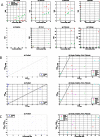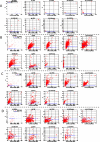Identification of leader and self-organizing communities in complex networks
- PMID: 28386089
- PMCID: PMC5429660
- DOI: 10.1038/s41598-017-00718-3
Identification of leader and self-organizing communities in complex networks
Abstract
Community or module structure is a natural property of complex networks. Leader communities and self-organizing communities have been introduced recently to characterize networks and understand how communities arise in complex networks. However, identification of leader and self-organizing communities is technically challenging since no adequate quantification has been developed to properly separate the two types of communities. We introduced a new measure, called ratio of node degree variances, to distinguish leader communities from self-organizing communities, and developed a statistical model to quantitatively characterize the two types of communities. We experimentally studied the power and robustness of the new method on several real-world networks in combination of some of the existing community identification methods. Our results revealed that social networks and citation networks contain more leader communities whereas technological networks such as power grid network have more self-organizing communities. Moreover, our results also indicated that self-organizing communities tend to be smaller than leader communities. The results shed new lights on community formation and module structures in complex systems.
Conflict of interest statement
The authors declare that they have no competing interests.
Figures





Similar articles
-
Identification of hybrid node and link communities in complex networks.Sci Rep. 2015 Mar 2;5:8638. doi: 10.1038/srep08638. Sci Rep. 2015. PMID: 25728010 Free PMC article.
-
Triadic closure as a basic generating mechanism of communities in complex networks.Phys Rev E Stat Nonlin Soft Matter Phys. 2014 Oct;90(4):042806. doi: 10.1103/PhysRevE.90.042806. Epub 2014 Oct 10. Phys Rev E Stat Nonlin Soft Matter Phys. 2014. PMID: 25375548
-
Social significance of community structure: statistical view.Phys Rev E Stat Nonlin Soft Matter Phys. 2015 Jan;91(1):012801. doi: 10.1103/PhysRevE.91.012801. Epub 2015 Jan 5. Phys Rev E Stat Nonlin Soft Matter Phys. 2015. PMID: 25679651
-
Markov dynamics as a zooming lens for multiscale community detection: non clique-like communities and the field-of-view limit.PLoS One. 2012;7(2):e32210. doi: 10.1371/journal.pone.0032210. Epub 2012 Feb 27. PLoS One. 2012. PMID: 22384178 Free PMC article.
-
Homophyly/Kinship Model: Naturally Evolving Networks.Sci Rep. 2015 Oct 19;5:15140. doi: 10.1038/srep15140. Sci Rep. 2015. PMID: 26478264 Free PMC article.
Cited by
-
Critical analysis of (Quasi-)Surprise for community detection in complex networks.Sci Rep. 2018 Sep 27;8(1):14459. doi: 10.1038/s41598-018-32582-0. Sci Rep. 2018. PMID: 30262896 Free PMC article.
References
Publication types
Grants and funding
LinkOut - more resources
Full Text Sources
Other Literature Sources

